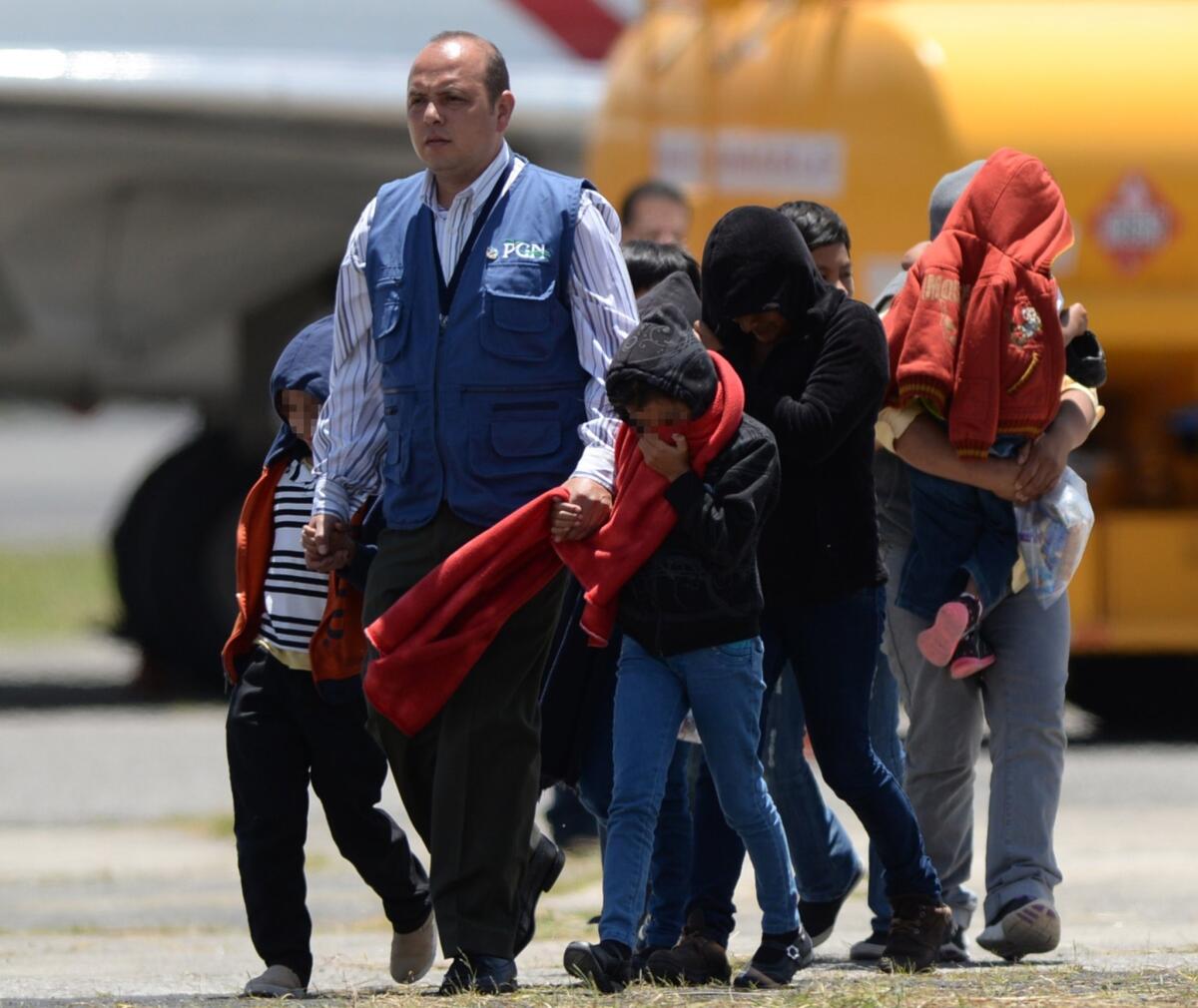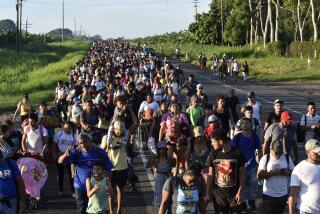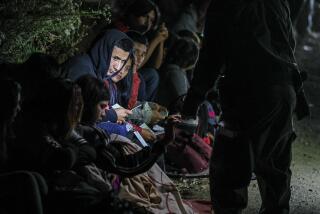Report: 117% increase in children 12 and younger crossing border alone

Reporting from Houston — Not only have more unaccompanied children illegally crossed the southern border this year — more than twice last year’s total — but they are crossing at much younger ages, according to a study released this week.
There has been a 117% increase in apprehensions among unaccompanied children ages 12 and younger and a 12% increase among teenagers between fiscal year 2013 and the first eight months of fiscal year 2014, according to government statistics obtained through a Freedom of Information Act request by the Pew Research Center. Also, the number of unaccompanied girls that have been caught crossing the border illegally has increased more rapidly this year than the number of boys, Pew research found.
“These under-12-year-old children who are coming across the border unaccompanied, many of them are coming from Honduras, Guatemala and El Salvador,” said one of the authors of the study, Mark Lopez, Pew’s director of Hispanic research. “In the last year, there has been a change in the composition of the unaccompanied minors who are apprehended.”
Since October, more than 57,000 youths have crossed the southern border unaccompanied, meaning without a parent or guardian. Most come from Central America and cross into the U.S. through the Rio Grande Valley in Texas.
In recent days the number of children making the perilous journey has dipped, but federal officials have cautioned the decrease may be temporary. The Obama administration and Congress have been scrambling to cope with the humanitarian crisis, promising expedited processing and deportations. Advocates have called for more lawyers and aid for young migrants thrust into a complicated court system.
Although the increase among migrants ages 6 to 12 was significant, they made up only 14% of total youths apprehended at the border, according to the Pew report, which provides the first detailed portrait of the age and nationality of child migrants detained.
There are still more 13- to 17-year-olds crossing, 84% of youths apprehended. Most are 16- and 17-year-olds, Lopez said.
Fewer than 1% of children caught this year were younger than 1 year old, and only about 2% were 5 or younger, the report said.
The number of unaccompanied children varies by country. The share of minors 12 and younger among Honduran children making the trek alone increased to 27% from 20%. The number from El Salvador rose to 22% from 17%; Guatemala doubled to 10%.
By contrast, this year just 3% of Mexican apprehensions were young children and the percentage of young children was unchanged, the study said.
“The fact that Hondurans represent the highest percentage [27%], followed by Salvadorans, makes clear that the major push factors are violence,” said Susan Terrio, an anthropology professor at Georgetown University who has interviewed dozens of unaccompanied immigrant children.
The increase among unaccompanied teenage girls caught illegally crossing is highest among girls from Honduras, (5,300), followed by El Salvador (3,792), and Guatemala (2,699), according the Pew results released Friday.
President Obama was meeting with the leaders of Honduras, El Salvador and Guatemala on Friday to discuss the surge in unaccompanied children.
Overall, the number of unaccompanied girls increased 77% so far this fiscal year to 13,008, compared with 7,339 last year. Far more boys are apprehended at the border, but their ranks have grown more slowly -- 8% during the same period, or 33,924 this year compared with 31,420 last year.
The number of girls 12 and younger has grown even faster, 140%, while the number of boys the same age doubled. Apprehensions of unaccompanied teenage girls are up 62% this year, while among teenage boys there’s been almost no increase.
The number of children caught crossing the border illegally with a parent or guardian nearly tripled in less than a year, according to the Pew analysis. So far this fiscal year, 22,069 accompanied children were apprehended, compared with 8,479 last year. More than half, 12,074, came from Honduras, a 434% increase from last year.
Migrant children traveling with a parent tended to be younger; about 81% were 12 years or under, compared with 16% of unaccompanied children.
“The fastest-growing population is parents and young children,” Terrio said, “Because under U.S. Immigration law, children are considered as appendages of their parents, some attorneys are reporting that children are being piggybacked onto to their parents’ claims for asylum relief. Thus, if the parent’s claim is denied, the kids are also denied. That is, some children’s cases could qualify for legal relief if they were considered alone or apart from the parent’s claim.”
Those children traveling with a parent or guardian may actually at a legal disadvantage compared with unaccompanied peers, said Bryan Johnson, a New York-based immigration lawyer who works with unaccompanied youth.
Those who arrive unaccompanied often join parents who have been in the U.S. for years, have developed support networks and know where to turn for legal help, he said. With children who arrive accompanied, he said, “The parents don’t know that much more about the immigration courts than they do.”
Johnson has been working to shore up protections for Central American migrant youths’ due process, including a 2008 law, the William Wilberforce Trafficking Victims Protection Act, that entitles them to court hearings before they can be deported. Mexican migrant youths can be more quickly repatriated as a voluntary return.
Next week, Johnson and three young clients from Guatemala, Honduras and El Salvador are scheduled to testify in favor of the 2008 law before the Congressional Progressive Caucus.
The three youths are a 12-year-old girl who fled Honduras after witnessing a killing, a 15-year-old boy who fled gang violence in El Salvador and a Guatemalan girl, also 15, who fled sexual abuse by a neighbor.
“What we’re really concerned about is that Congress and the president are going to treat Central American children the way they are treating Mexican children,” and deport them rapidly, Johnson said.
Lawmakers who have proposed rewriting the law in the wake of the influx insist that’s not the case.
Rep. Henry Cuellar, a Democrat from the Rio Grande Valley in Texas, epicenter of the immigrant influx, recently joined Senate Minority Whip John Cornyn (R-Texas) in proposing legislation that would speed deportation of young migrants and expand voluntary return to include Central American youths. But he insists the proposed legislation, called the Humane Act, “maintains all legal protections for unaccompanied children.”
“Instead of waiting three to five years for their time before a judge, as is the situation under current law, my legislation would ensure that every child receives due process in a timely manner,” Cuellar said in a statement, adding that the act would “close the loophole in current law that provided an incentive for criminal organizations to engage in human trafficking.”
Twitter: @mollyhf
More to Read
Sign up for Essential California
The most important California stories and recommendations in your inbox every morning.
You may occasionally receive promotional content from the Los Angeles Times.











